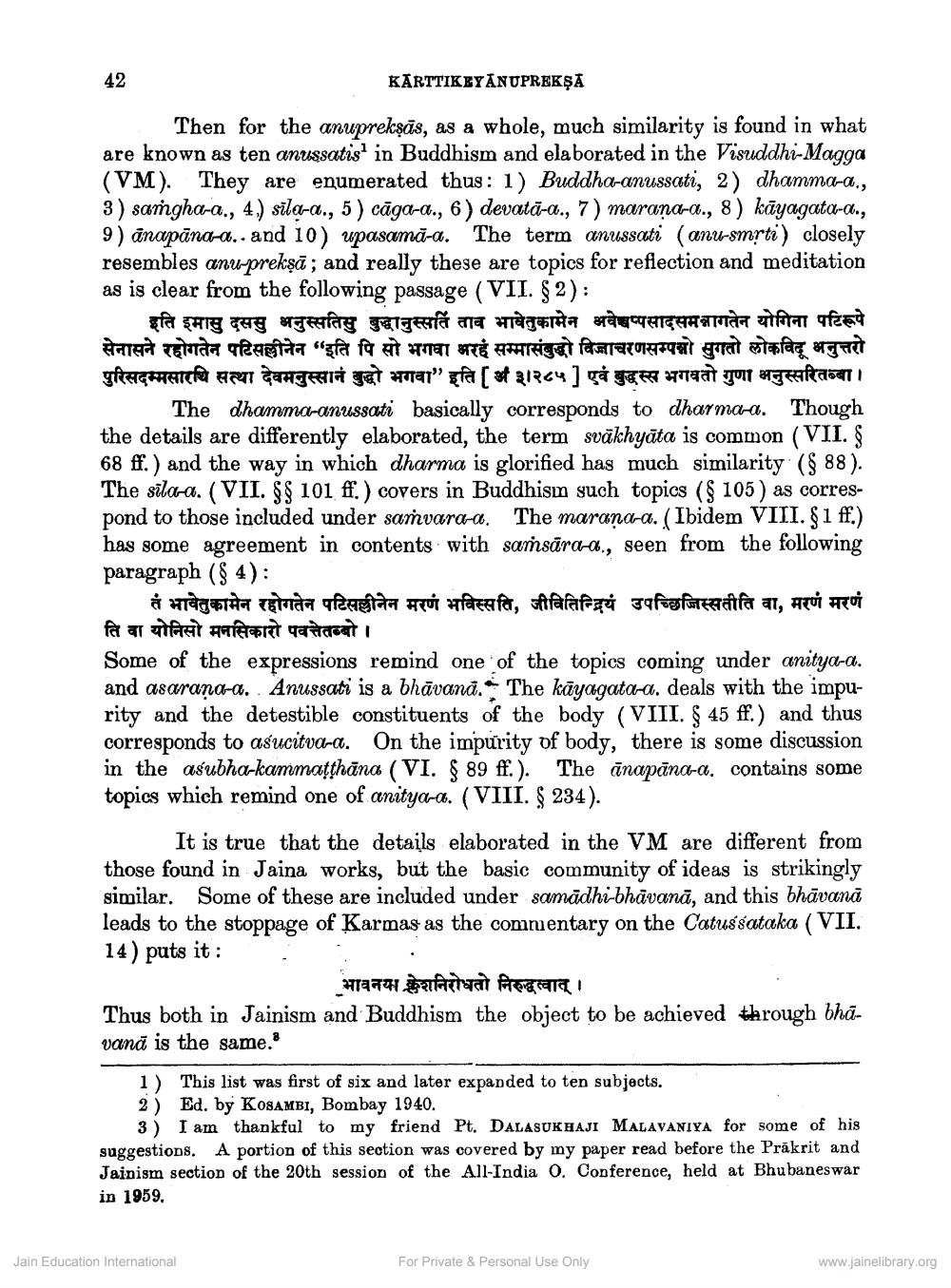________________
42
KĀRTTIKEYANUPREKŞA
Then for the anuprekşās, as a whole, much similarity is found in what are known as ten anussatis' in Buddhism and elaborated in the Visuddhi-Magga (VM). They are enumerated thus: 1) Buddha-anussati, 2) dhamma-a., 3) samgha-a., 4.) sila-d., 5) cāga-a., 6) devatā-a., 7) marana-a., 8) kāyagata-d., 9) ānapāna-d.. and 10) upasamā-a. The term anussati (anu-smrti) closely resembles anu-preksā; and really these are topics for reflection and meditation as is clear from the following passage (VII. $2):
इति इमासु दससु अनुस्सतिसु बुद्धानुस्सति ताव भावेतुकामेन अवेचप्पसादसमनागतेन योगिना पटिरूपे सेनासने रहोगतेन पटिसल्लीनेन "इति पि सो भगवा अरहं सम्मासंबुद्धो विजाचरणसम्पनो सुगतो लोकविदू अनुत्तरो पुरिसदम्मसारथि सत्था देवमनुस्सानं बुद्धो भगवा" इति [अं३।२८५] एवं बुद्धस्स भगवतो गुणा अनुस्सरितब्बा।
The dhamma-anussati basically corresponds to dharmaa. Though the details are differently elaborated, the term svākhyāta is common (VII. $ 68 ff.) and the way in which dharma is glorified has much similarity ($ 88). The sila-a. (VII. $$ 101 ff.) covers in Buddhism such topics ( 105 ) as correspond to those included under samvara-a. The marana-a. (Ibidem VIII. $1 ff.) has some agreement in contents with saṁsāra-a., seen from the following paragraph (§ 4):
तं भावेतुकामेन रहोगतेन पटिसल्लीनेन मरणं भविस्सति, जीवितिन्द्रियं उपच्छिजिस्सतीति वा, मरणं मरणं ति वा योनिसो मनसिकारो पवत्तेतब्बो । Some of the expressions remind one of the topics coming under anitya-a. and asarana-a. Anussati is a bhāvanā. The kāyagatad, deals with the impurity and the detestible constituents of the body (VIII. $ 45 ff.) and thus corresponds to asucitva-a. On the impurity of body, there is some discussion in the asubha-kammatthāna (VI. $ 89 ff.). The ānapāna-a. contains some topics which remind one of anitya-a. (VIII. $ 234).
It is true that the details elaborated in the VM are different from those found in Jaina works, but the basic community of ideas is strikingly similar. Some of these are included under samādhi-bhāvanā, and this bhāvanā leads to the stoppage of Karmas as the commentary on the Catussataka (VII. 14) puts it : :
भावनया क्लेशनिरोधतो निरुद्धत्वात् । Thus both in Jainism and Buddhism the object to be achieved through bhavanā is the same.
*
I am
1) This list was first of six and later expanded to ten subjects. 2) Ed. by KOSAMBI, Bombay 1940.
3) I am thankful to my friend Pt. DALASUKHAJI MALAVANIYA for some of his suggestions. A portion of this section was covered by my paper read before the Präkrit and Jainism section of the 20th session of the All-India O. Conference, held at Bhubaneswar in 1959,
thankful to
section was covered by W. Conference, held
Jain Education International
For Private & Personal Use Only
www.jainelibrary.org




